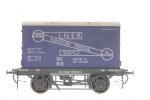4COR
Member
- Joined
- 30 Jan 2019
- Messages
- 460
On the BBC today, a story of how a 100 year old LNER removals wagon has been unearthed in a field near Antwerp:

From the article:

Century-old LNER train carriage unearthed in Belgium
The wooden truck was discovered by archaeologists in Antwerp.
www.bbc.co.uk
From the article:
The find, uncovered in Antwerp, appears to be a wooden removals truck used to carry people's belongings when they moved house, according to rail company LNER.
The York-based firm said it was "a mystery" how the carriage came to be buried in a field in Antwerp.
It added there was "very little left of the relic" as it had disintegrated while being excavated.
London and North Eastern Railway services began operating on what later became known as the East Coast Mainline in January 1923.
Some services were hauled by famous locomotives such as Flying Scotsman, Mallard and Sir Nigel Gresley.
The LNER name returned to the route in June 2018, when previous operator Virgin Trains East Coast returned the franchise to the government.
LNER communications director Stuart Thomas said: "Just last year we celebrated 100 years since the LNER came into being in 1923.
"In our 101st year it’s incredible to discover a little bit of LNER history has been buried in a field in Belgium for so many decades."


 ) if it had been hired by a family moving home, from an LNER-served UK location, to a location near the container's burial site.
) if it had been hired by a family moving home, from an LNER-served UK location, to a location near the container's burial site.